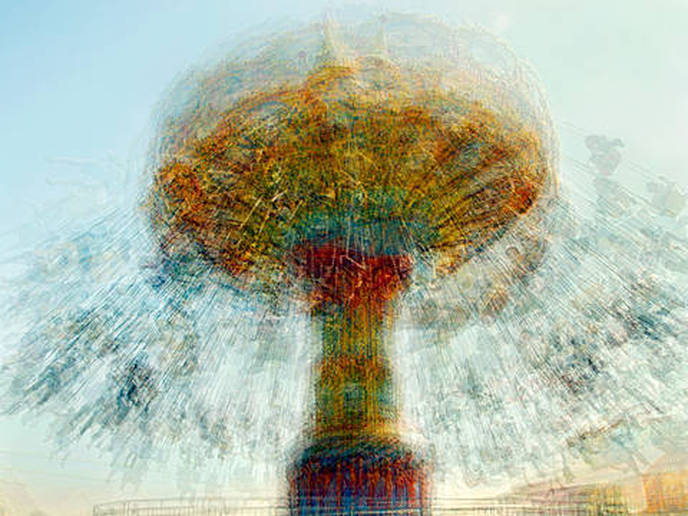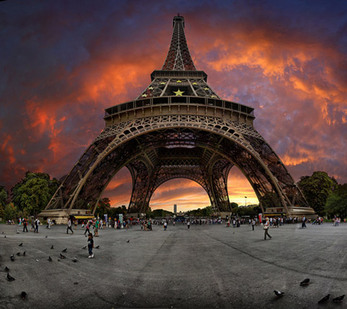This image was taken by me and is in the style of Batistini Gaston because it was taken with a fish eye lens, The image shows great height, depth and distance.
I found the original image on Google but could not find the photographer who created it, However I still found the photograph inspirational as it was edited well and I wanted to try it for myself. The image is very sharp in the focal point (the city image) and blurred in the background, this helps the viewer focus on the main part of the image. If i was to change anything about the original image it would be to higher the brightness and contrast, and lower the lower the amount of shadows. Lowering the amount of shadows would darken the edges almost giving the photograph a border. To create my version of the image i used Photoshop elements 9. First, i used the blur tool to blur all of the image but where the city image would be. I then opened the city image, made it smaller and placed it over the lens of the camera and used the eraser tool to simply go round the image and make it the right size. If i was to change something about my image it would be to use a more detailed and sharper image on the lens.
My Image ;
To begin with I used the selection tool on Photoshop elements 9 to selection the shape of the person, in this case Sara. I then added a new layer, made the original layer invisible and copied and pasted the selected shape in to the newly created layer. Using the brush tool with the colour black selected I coloured the image to make it all black. Then change the opacity to around 65%-72%, mine being 69%. I then went to file>open and found what would be my background layer. Also changing the opacity on this image to around 78%-80%, mine was 79%. I then changed the brightness making it lower and changed the contrast making it higher. Then I dragged the silhouette image into the background and moved it around until I thought it looked good. Then my image in the style of Jasper James was created.

The photograph I have chosen to write about was taken by Pep Ventosa and is called Santa Cruz Sea Swings‘. It comes from the theme of surrealism and I think the work recreates the movement of the swings. In the picture I can see swings, usually found in a fair, very colourful with lots of lights. I think the photographer was trying to portray the craziness of fairs and rides by making the image wild and colourful. In the foreground the swing frame where main focus point is found as it’s the boldest and darkest area, the middle-ground is where all the people are sat, they aren't as noticeable as the middle of the swing frame as they have no colour and possibly a lower opacity, the background is just pale blue, helping us focus on the swings as the image is not overwhelming with things to look at. This piece is easy to recreate yourself, using Photoshop. It is made up of lots of layers of the same image. It is an easy to do technique; however the same image can never be re-created which makes everyone unique. Ventosa may have used the rule of thirds as there are no big empty spaces and if the lines were there, there would be something in every section. The attitude of the image is wacky and strange. This photograph makes me feel dizzy and almost hypnotized it reminds me of dreams and imaginations because of the colour and the fact the ride is quite childish. I think the photographer wanted us to feel astonished and amazed by the image as it’s very impressive. The piece of work makes me think of summer, the sky in the background is a nice blue colour and the lighting is good. I chose to write about this piece of work because I liked it so much, it baffles your eyes and makes you interested and want to look closer. How Ventosa didn’t make the layers go left and right only up and down works well in this piece is as it creates height. I have been inspired by this piece of work to create my own images like this in the style of Pep Ventosa. (They are below)
This technique is simple but effective. i used Photoshop , and all i did was create around 14 layers of the same image, setting each with a low opacity, placing them in different places making sure all layers are visible and none of them line up. On some layers you can add a filter of your choice, or not!
Earlier this October I took a trip to Manchester to take pictures of various things including, building, signs and general things in the city. Some of these pictures will be the basis of my city project. Although i captured some good shots in Manchester i will also be visiting many other cities. When i was in Manchester the weather was not at its best, however i think my pictures still have good contrast and colour.

The photograph I have chosen to write about was taken in 2008 by Batistini Gaston with a Canon EOS 5D. In this image has captured the very tall Eiffel tower very detailed in the foreground, with a very unusual pink and orange coloured sky in the background. However it was taken with a fish eye lens. A fish eye lens is a wide-angle lens that gives an image a round feel and can provide a very surreal picture. Gaston is a married man living in Belgium, who said in an interview ‘I like colours, then I would say Colourful, straight line, sharpen. And LARGE’ which describes this image and his entire image collection exactly. Paris is known for being a romantic city, and this piece of work shows France’s landscape beauty. I think the photographer was trying to capture the stunning French architecture whilst making it romantic with warm autumn colours. The Eiffel tower is the main focal point but there are many small details like the pigeons and very faintly in the background, a tower, which ensure no empty spaces. I chose to write about this piece of work because it’s unusual, unique and inspiring. It inspires me to take photographs as well as this and in the same style using a fish eye lens. This photo is even unique to Gaston himself, as I found this photograph on his Flickr along with many other brilliant images, but not one like this one; mostly with bright eye catching colours, not using a fish eye lens.